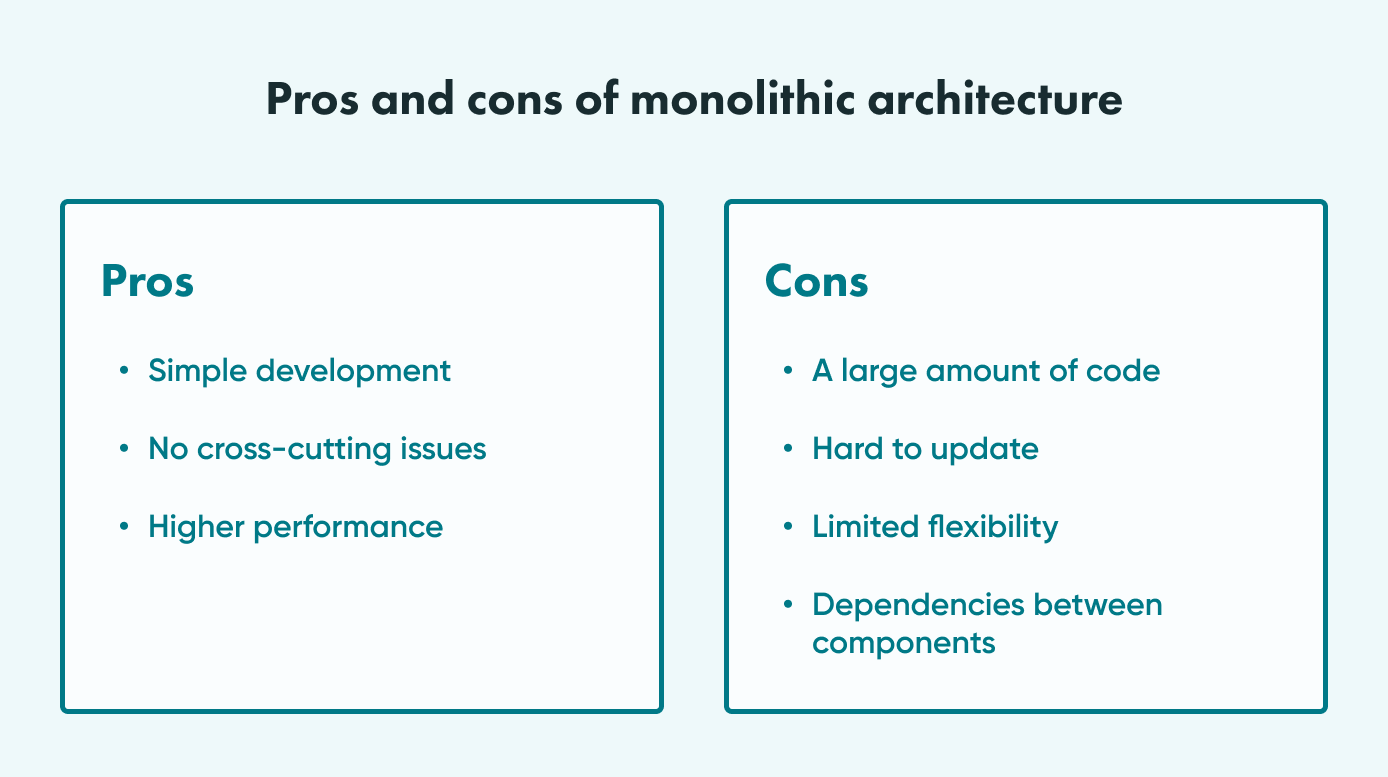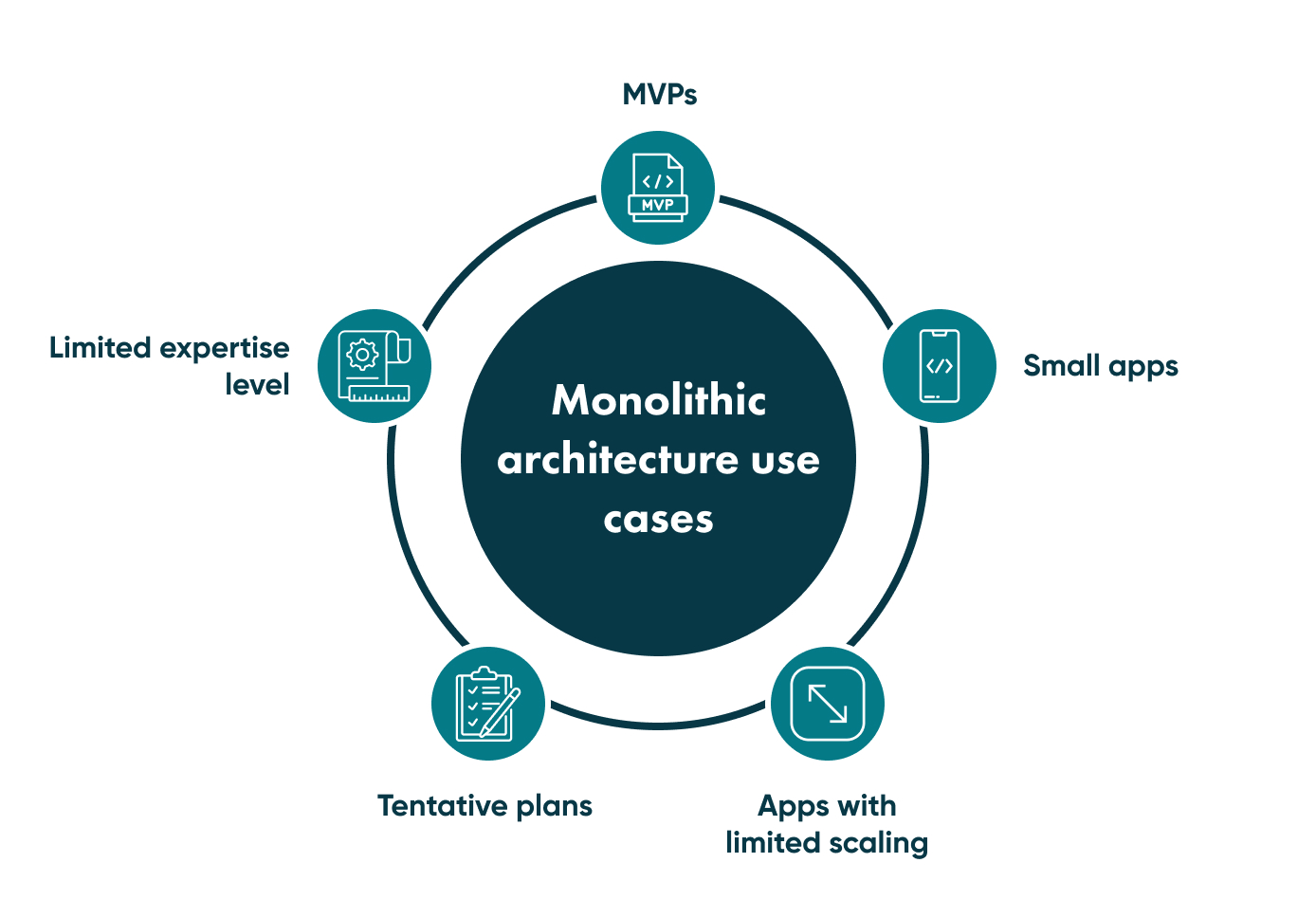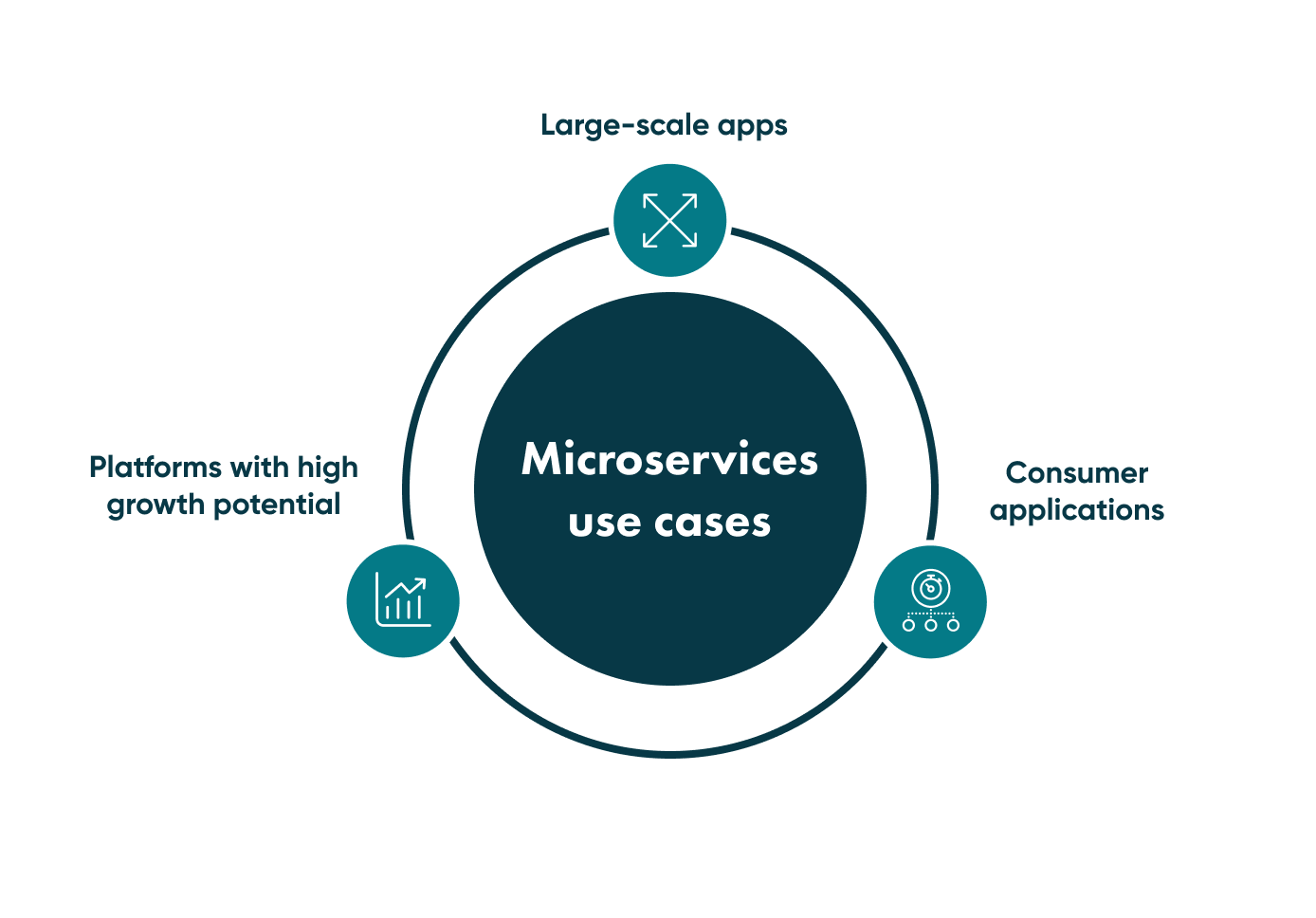Monolith vs Microservices Architecture: Which Is the Best Choice for Your Business?


The development of your application. This is one of the first things that come to your mind when you start an online business that revolves around digital services.
Yes, you need to make sure that your software or application development project is in capable hands, whether it's an internal team or a custom software developer. But you also need to participate in more technical decisions, like choosing between monolith vs microservices architecture, in order to create a detailed plan.
The process of building an app is similar to that of a house. In simple terms, the architectural elements are the frame or backbone that supports the rest of the structure.
This is the same with software, as the modern world of IT product development provides two methods: a monolithic architecture and a microservices architecture.
Each of them has its pros and cons and individual characteristics.
Why should you know about it? Because it helps you save costs and choose the right solution for your project. We will explain to you what every option is, their benefits and drawbacks, and when to use them.
Monolithic systems: What are they?
Monolithic architecture can be defined as a conventional software model that looks like a single module and works independently from other applications. So, in monolithic software, the entire application works using one base or set of parameters.
The word monolithic means huge and vast. These two words perfectly summarise what monolithic architecture is in the context of creating software.
This type of architecture consists of an extensive computing network with a single code base that combines all business tasks. So it is necessary to update the tech stack through the codebase and then create and deploy an updated interface version on the server side to make changes in monolithic apps. Therefore, it limits updates and is harder to maintain.
On the other hand, monoliths are convenient in the early stages of projects to simplify deployment and code management. It makes it possible to release an application in a shorter turnaround.
Microservices architecture defined
Microservices architecture opens up a world of opportunities during the development process.
In this model, the application consists of separate individual modules made of small code blocks. Each module has its own logic and database, so the individual blocks communicate with one another via protocol-independent technology.
Want to see a live microservices example in action? Online marketplaces are an excellent case.
The catalogue of goods, user ratings, chat, and reviews are all separate microservices. Each microservice does its job within one platform, doing so independently.
A microservices application provides more capabilities than a monolithic application, but is also more complex in nature.
Create a microservices-based application together with Go Wombat — contact us!
Pros and cons of monolithic architecture
Monolithic applications have advantages and disadvantages. Let’s go over them to have a comprehensive picture of this type of technology.

Benefits of monolithic architecture
First, let’s go over the reasons why you may want to choose a monolithic app architecture.
Simple development
When you opt for a software monolith, the development process is concentrated in one place. Therefore, it is easier to integrate tools for simplified development, like libraries and frameworks.
Moreover, if it’s ever necessary to change the software components, developers don’t need to do it separately — everything is implemented in one location.
No cross-cutting issues
Many apps depend on tasks performed between software components: logs, speed limits, audit trails, and so on.
A monolithic architecture removes all these issues since everything is concentrated in one code and works in one application.
Higher performance
As long as the app or software is created correctly, monolithic architecture will work more quickly than microservices.
This is due to the fact that a software monolith uses a single-code base of software that works from one place.
Drawbacks of monolithic applications
Now, let’s go over the disadvantages of monolithic applications.
A large amount of code
If the developed product is enormous and requires scaling, it may result in massive amounts of additional code. This, in turn, can complicate the long-term management of the application.
Hard to update
Sometimes, it is necessary to add a new feature to the software. However, a monolithic architecture may result in several barriers that stop developers from implementing the updates quickly.
Unfortunately, in some cases, adding a new feature means the re-development of the entire application. Therefore, it is more expensive and time-consuming than modular structures.
Limited flexibility
As we saw in the previous point, the integration of a new feature can become a big barrier. In some cases, it means that the base code of the application needs to be completely rewritten.
This situation applies to bug fixing and updates as well. That’s why a monolithic architecture is hard to adapt and change after it's been created.
Dependencies between components
Having a single system is an advantage from a performance perspective. But this can also become a nuance if something impacts even the smallest part of the software.
This means that any bug or error can slow down or stop the entire application.
The pros and cons of microservices architecture
Now, let’s discuss the strengths and weaknesses of microservices.
Advantages of microservices
The benefits of microservice applications include the following.

Scalability
One of the biggest microservice benefits is its scalability. In a microservice-based app, features and functionalities can be updated and extended according to your needs.
The rest of the system can remain the same, so you don’t have to plan for changes in every component unless you’re ready.
Modularity
Modularity is a crucial benefit of microservices architecture.
In a microservices architecture, an application is divided into a collection of loosely coupled and independently deployable services, each responsible for a specific business capability.
Modularity simplifies the maintenance of microservices. Each service has a smaller codebase and focuses on a particular business capability, making it easier to understand, update, test, and debug.
High fault-tolerance
If one of the microservices drops down, the rest of the application will still function. Thus, malfunctions in separate services won’t always interfere with the entire workflow or even impact the main functionality.
Flexibility
A microservices application can be changed quickly, and new technology can be integrated within a short period.
If there are any failures, developers can simply roll back the changes. There are fewer risks whenever it’s time to update local or cloud microservices, so developers spend less time performing the work.
Simplicity
The fewer lines of code there are, the simpler it is for developers to deal with it and change or fix something. One of the biggest benefits of microservices is that they are simple, individual blocks. So, they are not as time-consuming to build or adjust as monolithic architecture.
Faster deployment
Having a small amount of code makes it possible to deploy the software faster. It also contributes to regular and quicker release cycles. Updates can be done not once per month but once per week, if necessary.
Cons of a microservices architecture
When comparing monolithic vs microservices, it may seem like the former has more advantages than the latter. But microservices architecture still has its drawbacks.
More challenging communication
As every functional element is isolated, developers must work carefully on building reliable communication between each microservice.
These services or code blocks will need to exchange requests and responses. Thus, the more services there are, the more complicated the communication process will become.
Testing complexity
The challenge here is that QA engineers have to evaluate each code block separately first and then ensure that its communicating and interacting with other microservices properly.
Slower performance
Microservices' performance is usually slower than monoliths since there are communication barriers between microservices. This means that the performance ceiling for microservice architecture is inherently lower than monolithic applications.
Why should complex applications be built using microservices architecture?
Microservice architecture is more complicated, but developers can also set up this type of structure relatively quickly. This is because specialists can work on a few modules in parallel.
Even though a microservice application is more expensive, it is also more adaptable.
This is where horizontal scaling shows its worth. Let’s take an online store as an example.
During the high season, the online store will expect its modules to handle a greater load, which means more server power. But after the hot season, additional server capabilities can be turned off and redirected to support other functionalities.
In contrast, a monolithic application has to be designed for a specific number of users, say an average attendance of up to 1000 visitors daily. This means that this type of app will have problems if the user base starts growing beyond this point.
Using microservices architecture, this issue can be solved by adding new modules and servers.
Furthermore, microservices can receive requests from each other, not only from users.
Is it possible to migrate from monolithic to microservices?
The migration from monolith to microservices is possible, but it means that the foundation will have to be rebuilt entirely.
This is time-consuming and resource-intensive. So, if your business requires the creation of a complex high-load application with scaling capabilities, we recommend choosing a microservice architecture. It will be a more cost-effective and profitable alternative.
However, there is a third option — a hybrid architecture.
Hybrid architectures
This type of architecture is a kind of compromise. It’s a model where basic functionality is implemented as a monolithic application, and additional features are like microservices.
Many B2B and B2C companies choose this option. A hybrid architecture combines the stability of monolithic applications with the flexibility and functionality of microservices to reduce the drawbacks of each method.
We’re more than capable of creating and collaborating on this type of structure at any stage, so reach out to us if you have any questions.
Microservices and containers
Another crucial thing to consider is the use of containers with microservices. Containers are lightweight virtual operating systems that can run microservices or other software internally.
Microservices are not the same as containers, but they are often used with containerisation tools like Kubernetes or Nomad.
Thus, containers make it possible for developers to deploy microservices in high-performance and lightweight environments, and containers can be easily moved, making a containerised app extremely flexible.
How long does it take to build your monolithic or microservice application? Get a detailed estimate.
Monolith vs microservices: When to use them
We have already mentioned that microservices play better for complex apps, while monolithic apps are better left for simpler software.
Thus, you should choose between monolithic or microservices architecture based on your needs.
Let’s take a closer look at the use cases for each one.

MVPs
Monolithic architecture is suitable for the development of a minimum viable product or MVP.
In short, a monolithic architecture allows you to quickly create the MVP, release it, and gather user feedback to identify its strong and weak sides.
You should also know how to reduce MVP development costs, so read our detailed article to find out more.
Small apps
As you already know, it’s best to take a monolithic approach when building small and straightforward apps.
The reason for this is that the development time will be much faster. Plus, simple apps don’t require a bunch of microservices since they only perform a few functions.
Apps with limited scaling
In case you and the development team identify that your app won’t require scaling, a monolithic architecture is probably a better choice.
After all, a monolithic application is easier to manage as long as it's only used by a small number of people.
Tentative plans
If you don’t know the final purpose of your application and don’t know how it will grow, then you can choose a hybrid architecture option that’s based on a monolithic architecture.
If you opt for this, the basic functionality will be a monolith and all other features will be implemented as microservices.
Limited expertise level
Hiring a development team with a high skill-level can be more challenging.
The development of microservices apps requires more skills and talent. Monolithic apps, on the other hand, can be built by a less experienced team.
As long as you hire a professional and highly qualified team of professionals like Go Wombat, you’ll get the results you need from your software, no matter what.
Microservices use cases
Now, let’s take a look at some cases where going from monolithic to microservices may be the best alternative.

Large-scale applications
Large-scale and complex applications with rich functionalities cannot be monolithic. Microservices architecture is the best way to make bigger apps more flexible and scalable.
Platforms with high growth potential
Large apps that have vast growth potential must use microservices architecture to integrate all the innovative technologies faster.
This helps ensure that the app won’t lag behind competitors and will be updated quickly and efficiently.
Consumer applications
Microservices architecture can also be applied effectively to B2C (business-to-consumer) applications, such as mobile apps, e-commerce platforms, social media platforms, and on-demand service apps.
B2C applications often experience variable and high traffic loads. Microservices allow individual application components to be scaled independently, enabling efficient resource utilisation. For example, if the payment service is experiencing high demand, it can be scaled up without affecting other services.
Also, B2C apps often require quick adaptations to changing market trends and user demands. Microservices enable flexibility in technology choices and development processes. Teams can select different technologies or programming languages that best suit the requirements of each service.
Unlock Success with Premium Software Development
Contact us


Summary: Which architecture you should choose
We hope that this blog helps you choose the right type of architecture for your app.
If you plan to build an extensive and resource-consuming application, then microservices are your choice. Besides, microservices contribute to making your apps more secure if you are concerned about cybersecurity.
On the other hand, monolithic software development is an option if you need to create a lightweight and simple app.
The development of a monolithic app will be more cost-effective. However, developing a microservices app will result in future cost savings when the app has to be scaled, if this point ever comes.
The architecture you choose will depend on the size and skills of the team you hire. A young and inexperienced team will unlikely be able to create complicated microservices-based software. However, there is always a simple answer: hiring a professional development team with expertise.
Entrust your software development to a trustworthy partner — Go Wombat is here to help with all your custom app needs. Book a consultation today!
How can we help you ?




